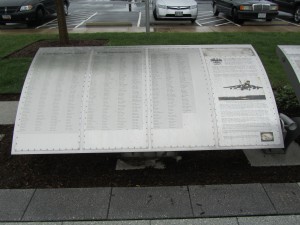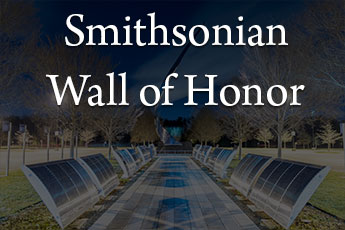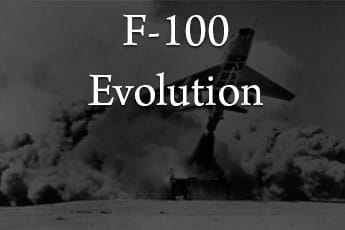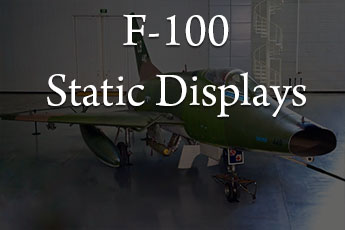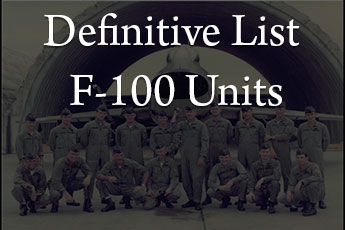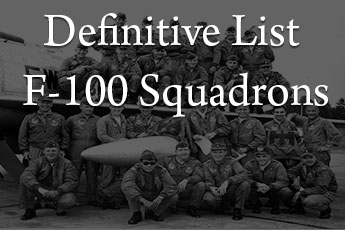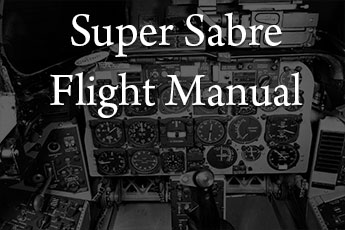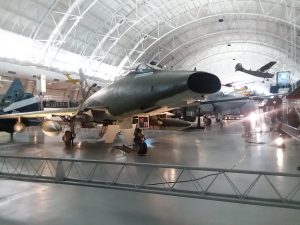
The Aircraft: The F-100 was originally designed as a supersonic air superiority follow-on to NAA’s famed F-86 Sabre Jet. Four models were produced: the F-100A, a pure “day fighter,” was soon replaced by the F-100C, which retained a potent air-to-air fighting capability, but also with new air-to-ground attack and, more importantly, tactical nuclear weapons delivery capabilities. Cold War-driven evolution continued with the development of the F-100D, with added flaps and much huskier conventional and nuclear weapons delivery capabilities, including offensive and defensive systems for air-to-air and air-to-ground combat.
Including the two-seat F-100F, the F-100 fleet was a powerful deterrent and provided effective multi-mission aircraft to growing Free World arsenals. The Hun saw service with the USAF and the Air National Guard (ANG), and also with foreign allies, including Nationalist China, France, Denmark, and Turkey.
The operational Hun era was from 1954 to 1972 for active duty USAF units, to 1979 for ANG units, and extended to 1998 with the QF-100 Full Scale Aerial Target Program (supporting other weapon systems and training). A total of 2,296 F-100s were produced, including two prototypes and seven RF-100As (modified for the clandestine aerial reconnaissance missions of the late 1950s). See the Udvar-Hazy Center display of F-100D Serial 56-3440 for a full description of a magnificent airplane.
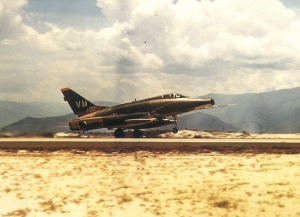
Combat Firsts & Records: With countless hours of conventional and nuclear alert on a global scale, and having periodically flown operationally as a “show of force” by small units on temporary duty (TDY) at bases in Thailand since April 1961, the first official combat strike in Southeast Asia (SEA) was flown on 9 June 1964 by eight F-100s from Da Nang Airbase, RVN, against Anti-Aircraft Artillery (AAA) sites in Laos. The first F-100 aircraft combat loss (with the pilot rescued) was on 18 August 1964 while defending downed friendly aircrew in Laos. From these beginnings, the air war heated up rapidly.
By 14 December 1964, major F-100 combat operations commenced by TDY units at Da Nang Air Base providing Combat Air Patrol (CAP) support to F-105s from Korat Air Base, Thailand, flying the first strike mission of a limited covert bombing campaign codenamed Barrel Roll. Subsequent Hun missions in that campaign included support in North Vietnam. The first Hun pilot loss was on 13 January 1965, when Captain Charles Ferguson was killed while defending a downed F-105 pilot. These early baptism-by-fire missions were the beginning of a long combat learning curve for the USAF, and for the men who proudly call themselves “Hun drivers.”
As the Vietnam War escalated, the roles and missions of the F-100 grew rapidly, and permanently based units became the norm. Close Air Support (CAS) became the primary Hun mission, as U.S. ground forces swelled markedly. CAP missions diminished rapidly as the F-4 was introduced to the theater—but Hun history records that the first MiG encounters with USAF fighters were on 4 April 1965, resulting in the first MiG kill claim (a probable) by Captain Donald Kilgus in his F-100D.
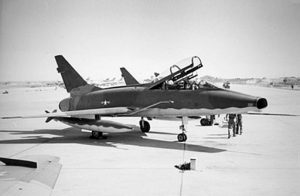
Another significant first for the Hun was as the first USAF fighter dedicated to Electronic Warfare (EW) in the “Wild Weasel I” program, which used highly modified F-100F aircraft to seek and destroy enemy AAA and Surface-to-Air Missile (SAM) sites. F-100Fs were also chosen to implement the Fast Forward Air Controller concept to improve interdiction results along the dangerous “Ho Chi Minh Trail.” It was known as the “Misty” mission, after their famous radio call sign.
The Hun’s combat record ended when the last ones, all belonging to the 35th Tactical Fighter Wing, left the SEA Theater in July 1971, reassigned to bases stateside. In all, the warhorse Hun flew 360,283 combat sorties in SEA (more than all other USAF fighters combined), with 242 losses!

